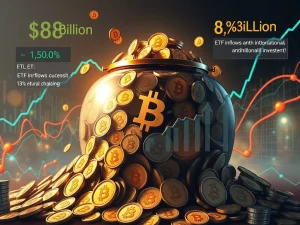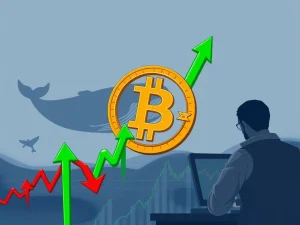Historic Bitcoin ETF Inflow: BlackRock Adds $970M, Bolstering Price

The world of cryptocurrency is buzzing, and if you’re following Bitcoin, you know why. Recent activity involving the BlackRock Bitcoin ETF highlights a major trend: institutional money is pouring in, providing significant support for the market. This isn’t just a small trickle; we’re talking about substantial investments that analysts believe are crucial for Bitcoin’s continued growth.
Understanding Recent Bitcoin ETF Inflows
A key event that captured attention was the massive investment made through BlackRock’s spot Bitcoin ETF, known by its ticker IBIT. On a single day, April 28, this fund purchased approximately $970 million worth of Bitcoin on behalf of its investors. Data indicates this was the second-largest daily inflow for IBIT since its launch in January 2024, surpassed only by a $1.12 billion inflow recorded earlier.
These large movements are important because they represent direct demand for Bitcoin from traditional finance channels. When funds like IBIT see such significant inflows, they must acquire the underlying asset – Bitcoin – to back the shares purchased by investors. This creates buying pressure on the Bitcoin market.
IBIT Dominance in the Spot Bitcoin ETF Market
While several spot Bitcoin ETFs are available in the U.S., BlackRock’s IBIT stands out. Following this recent surge, IBIT is confirmed as the largest spot BTC ETF by assets under management, holding over $54 billion. This figure represents more than half of the total market share among all U.S. spot Bitcoin ETFs.
The activity on April 28 saw IBIT’s near $1 billion inflow contributing significantly to the overall net positive flows for the U.S. spot Bitcoin ETF segment that day. While some other ETFs experienced outflows, IBIT’s strong performance ensured the total net inflow remained positive, totaling over $590 million across all funds.
How Bitcoin ETF Inflows Provide Market Support
Market analysts point to consistent Bitcoin ETF inflows as providing essential ‘structural support’ for Bitcoin’s price. Unlike speculative trading which can be volatile, these inflows represent sustained demand from institutional and retail investors accessing Bitcoin through regulated investment products.
This institutional demand is seen as a counterbalance to potential selling pressure. As one analyst noted, these inflows, combined with corporate buying, have been significant factors in Bitcoin’s recent price recovery. Another perspective highlights that weekly ETF inflows topping $3 billion, as seen recently, are the highest since November and reinforce this structural support.
The Broader Impact of Spot Bitcoin ETF Activity
The debut of U.S. spot Bitcoin ETF products in January 2024 marked a turning point. These products have made it easier for a wider range of investors to gain exposure to Bitcoin without directly holding the asset. This increased accessibility has channeled substantial new investment into the cryptocurrency market.
It’s estimated that in early 2024, these ETFs accounted for a significant portion, perhaps up to 75%, of the new investment flowing into Bitcoin as it crossed key price levels. This underscores the transformative role these investment vehicles are playing in the market structure and price dynamics of Bitcoin.
Conclusion: Institutional Demand Continues to Shape Bitcoin
The recent massive inflow into the BlackRock Bitcoin ETF is more than just a single data point; it’s a clear signal of ongoing strong demand from institutional channels. As IBIT and other spot Bitcoin ETFs continue to attract significant capital, they provide a fundamental layer of support for Bitcoin’s price. This trend suggests that institutional adoption through regulated products is a key driver in the current market cycle, potentially paving the way for further price appreciation as more investors gain access to Bitcoin via these accessible routes.









